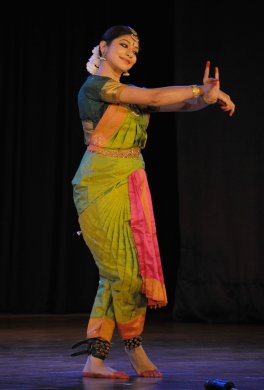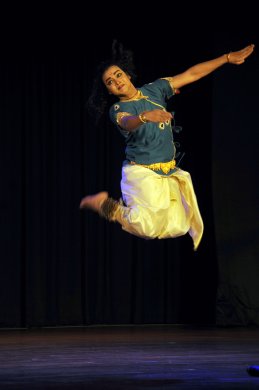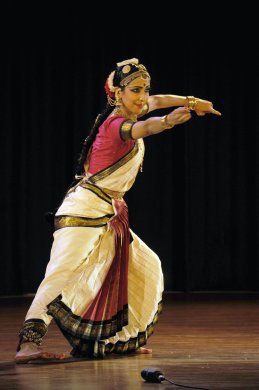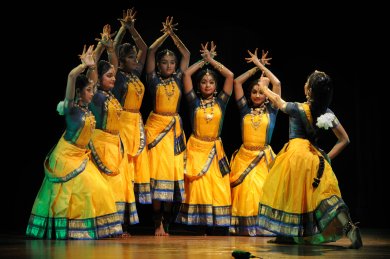
|   |

|   |
The Madras Music Academy Dance Festival - Day 3 - Veejay Sai e-mail: vs.veejaysai@gmail.com Photos: Thanthoni January 10, 2017 Chip off the old block The third morning of the Academy dance festival opened with a solo performance of Dakshina Vaidyanathan, the daughter of Bharatanatyam superstar Rama Vaidyanathan, and the granddaughter of veteran Guru Saroja Vaidyanathan who is Delhi based. This was her debut performance at the Academy’s festival.  Dakshina began her performance with the famous Narayana Theertha Tarangam “Aalokaye Sri Balakrishnam.” Set to a Ragamalika and eka talam, the composition was tuned by Delhi based dance singer Sudha Raghuraman who is a regular with most Delhi based Bharatanatyam dancers. Opening with Bahudaari and flowing into Shanmukhapriya, we saw Dakshina was filled with a great enthusiasm. The choreography is by Rama and we have seen the same being performed in earlier editions of the festival. Dakshina took time to warm up through this composition. The main piece for the morning was the famous Dandayudhapani Pillai varnam “Mohamaginen” set to Kharaharapriya ragam and adi talam. This varnam is known and has been done often. The heroine is smitten by love for Shiva. She tells her friend how the arrows of cupid are consuming her and to bring the lord to her before it gets out of control. Dakshina’s high energy dance was a great match to the mood and theme of the composition. However, the jatis written by Karaikudi Krishnamurthy didn’t seem to fit into the larger scheme of things. For one, they sounded way too abrupt and cluttered the whole composition. To move to these meant a lot of energy spent in trying to create a method out of complete abstract movements. One could see even Rama Vaidyanathan struggling through as she conducted the nattuvangam. Her ‘Tha Ha’ syllables came across as ‘Tahaa’ several times not going with the matras of the rhythmic cycle. Would the original jatis composed by Dandayudhapani Pillai have worked better for a debut performance at the Academy? We will never know. For once, the entire varnam seemed like a tedious effort. A slight twitch in her left eyebrow also affected the abhinayam sequences. This needs to be attended to with great care as it affects the mukhajabhinayam. In the Daasara pada “Saddu maadalu bedavo, Rangayya” composed by poet saint Purandara Dasa, the Gopika is irritated with Krishna for playing his flute and disturbing everyone around the house. After teasing him around and playing the fool, she in her own charming way steals Krishna’s flute and makes her exit. Dakshina is a greatly promising dancer. In the capital city of Delhi, she is easily the best. In fact, she has a far more expressive face and an agile body than most of the dancers in her age group. She has the blessing of gurus at home who can monitor her growth and the infrastructure to help her grow as a dancer of great merit. A few things she needs to work on are minor but important. If she continues this way, she is all set to be a star, like her mother. This debut performance at the Academy revealed her to be a chip off the old block. But we hope she will grow beyond that to mark her own artistic presence. The boisterousness of Banaras Gharana The first few names that come to mind when we think of the Banaras Gharana of Kathak are Pt Gopi Krishna and Sitara Devi. Her grand nephew Vishal Krishna could easily be the only worthy proponent of this style.  Vishal with his crop of curly locks and cherubic smile began his performance with an invocatory composition in raga Sohni. Dedicated to the mother goddess “Jai Jai Jagat Janani Devi” is a padanth of Pt Sukhdev Maharaj of his gharana. The bols of the padanth were drowned out in the loudness of the tabla playing by his brother Kushal Krishna. For the rest of the show, Kushal was to dominate this way with his fairly long and unnecessary tabla interludes that didn’t add much. One saw Vishal standing idle on stage fixing the strings of his kurta and so forth. In an exhibition of technical virtuosity, Vishal presented a series of thaat, aamad and padanths. The chautaal inspired from the Dhrupad tradition too was marred by Kushal’s indulgence. Vishal must get control over how he presents his shows without allowing for such incidents. Vishal’s main forte is his strong knowledge of laya. As the mainstay of his gharana, he displayed it with great ease and aplomb. He presented a Meera Bhajan “Tum bin mori koun khabhar” set to raga Mishra Pilu. Vishal’s abhinayam is not the best of his skills. Flashing one eyebrow up, biting the corner of his lips and the like, are the tackiness that come as a part of the loud and dramatic aesthetic the gharana is known for. If one discounts all those, Vishal is one of the best representatives of his style. Vishal also displayed his technical virtuosity by presenting the famous Thaali Naach (dancing on a brass plate) of the Banaras Gharana, in which his feet tapped out intricate rhythm patterns with ease. For his high energy presentation, Vishal got loud applause and a standing ovation. Uninspiring and pedantic The third evening of the Academy’s festival opened with the solo Bharatanatyam by Mythili Prakash. Daughter and disciple of Viji Prakash, Mythili is currently training with Malavika Sarukkai.  She began her performance with a composition of poet Subramanya Bharati titled ‘Shivashakti’ set to ragam Shivashakti and adi talam. Extolling the various divine aspects of the mother goddess, the Shakti Koothu was an energetic opening. One saw the singer Aditya Prakash constantly glaring into an open Mac book and singing out trying hard to reach the higher notes of the ragam. Mythili’s main piece for the evening was the famous Swati Thirunal composition “Sumasayaka.” The varnam is well known and one really doesn’t have to go into the details of each line. What was visible and lacking was Mythili’s usual energy. Where were the taut lines in her nritta? Where were her usual enthusiasm and the buoyancy of her dance? Where was that spark in her eyes? Why was all of this missing? It felt like she was putting herself through this, not for the love of it but to finish it soon. A simple example of how spaced out she was through the course of the varnam. The line went “Ramani ati shayane’ and we saw the nayika make a bed, shower it with flowers and douse it with so much perfume with vigorous hand movements. So much perfume, lord Padmanabha would have suffocated and fainted on that bed! One can go on about more of the sancharis that could easily be misinterpreted with the way they were depicted. This wasn’t what was expected from a dancer like Mythili. That too at the biggest of shows in the Academy.What was lost in translation was her gentleness at handling the literary qualities of the varnam with great sensitivity. Only few years ago on the same stage she gave a stunner of a show. This time the choreography was abrupt and not thought out at all. Her visibly slow and lethargic movements only added to this. Did she require time to warm up before she got into the mood of the varnam? One will never know! While her attempt at Oothukadu Kavi’s famous “Thaye Yashoda” in ragamThodi wasn’t any better, the following padam she presented saw her warm up finally to her act. Before the famous Sarangapani padam “Mogudochchi Piliche,” she made an announcement that didn’t come close to the meaning. To say “worldly duties are calling” (like pay pending bills? Or finish laundry?) is a far cry from the cultural context of the padam which says “my husband is calling.” The subtle misery of separation of the Virahini nayika was completely missing in the portrayal. She ended her performance with a thillana in ragam Vasanta, whose composer remains unknown. Aditya Prakash’s singing was stressed out. He has a robust base voice that can create melodious music if the right kinds of ragas are chosen. He ended up straining his voice singing the higher notes and in a high pitch. This was not one of Mythili’s best performances. She has dazzled us in the past and is capable of giving us fantastic art if all goes fine. We hope she bounces back to her usual self soon. The expectations on her are higher than they are on most others. The confusing dolls of Melattur When the stage lights came on, the audiences in the Academy were taken aback with the visual. Like a row of coloured glass bottles that pop out of a factory conveyer belt, a group of girls emerged from one wing and exited the opposite. Dressed in bright yellow silk skirts, or skirtish costumes were the students of Guru Sheela Unnikrishnan. With identical long hair braids decorated with feathery white flowers, they looked like a group of dolls. For the larger part of the show they all moved in tandem, almost like a big bunch of dancers would, in yesteryears Tamil cinema dance sequences.  Performing a selection of Narayana Theertha Tarangams in a program titled ‘Leela Taranga Margam’, the group of clones danced away. It makes no sense to go through the list of what they presented. All of it sounded and looked alike, except for a few formations they made, which is a commonality with all group performances. Groups are expected to have coordination and teamwork is an integral part of presentation aesthetics. In this case it was undoubtedly exceptional. What was not understandable was the nritta aspect. They claim to represent the Melattur style of Bharatanatyam. This style was devised by Guru Mangudi Dorairaja Iyer. A teacher and a researcher in dance, he authored a book titled ‘Swabodha Bharatha Navaneetham’. He also taught his dance to several dancers from the older generation but none of them pursued it enough to make a full performing career out of it. The mystery behind Melattur bani remains unsolved. How close or far are they from the great theatrical tradition followed by the Melattur Bhagavata Mela? This style hasn’t been the most popular one around and very less is known of its stylistics, approach to pure dance and abhinayam. It rests on the shoulders of gurus like Sheela and other practitioners of this style to orient audiences, create awareness and make their knowledge accessible to everyone. If they don’t take the initiative, how are audiences expected to understand their performance? For example, what is their dance vocabulary? Is it meant to be filmy in its approach like Sheela’s students presented it? What about it is exclusive to their style? How do they differentiate their style from the other existing banis of Bharatanatyam? They speak of ‘Shuddha Nrittam’. Is it physical or at another level of understanding? What are the visual signifiers of this for a lay rasika? This show raised serious questions on the very pedagogy of dance. Sheela’s dancers looked like well-dressed and presentable dolls, who are pretty to look at and were extremely talented, disciplined and coordinated. It would take much more effort in telling us more about their style and dance. The show, while pretty in its presentation, was empty in its content. Veejay Sai is a writer, editor and culture critic. Response Guru Sheela Unnikrishnan has responded to my review and critique of her group presentation in the Music Academy Dance Festival. She has given a lot of insights into the Melattur bani of Bharatanatyam that she has trained in. This knowledge received by me in a personal email is valuable and worth sharing for the entire dance community. I hope everyone can gain from this. Thank you, Guru Sheela, for this kind and timely gesture. - Veejay Sai (Jan 11, 2017) Dear Veejay Sai, My heartfelt thanks to you for reviewing our group performance at Music Academy’s Dance Festival 2017. The Melattur bani, as you had mentioned, is an uncommon style, which certainly needs documentation. I would like to take this into serious consideration and do all that can be done to record and document this legacy, with the aid of scholars. I was a student of Late Railway M. Sundaram, (a direct disciple of Mangudi Dorairaja Iyer) who established the renowned Sridevi Natya Kala Mandali at No.12, Gurumuthy Garden Street, Perambur, Chennai 600011, in Bharatanatyam, and a student of Padmabushan Dr. Vempati Chinna Satyam in Kuchipudi for a few years. When I learnt Bharatanatyam from Guru Sundaram, I barely had the opportunity of questioning him about the nuances and stylistics of this style. And as you have rightly mentioned, there are not many dancers practicing this bani of Bharatanatyam now. However with the guidance of Revathi Ramachandran (a renowned Bharatanatyam performer and teacher) and Gayathri Sundaram (who is not a performer herself) who were both direct disciples of Dorairaja Iyer, I have attempted to develop a deeper understanding of this style and its intricacies and also impart it to my students over the last 29 years. Evolution of the Melattur Bani From the traces of history, after the battle of Tallikota in 1565 A.D., the Vijayanagara empire declined. The Kuchipudi art form too, which was cherished by the Vijayanagara kings had to face downfall, due to lost patronage. The Nayakarajas of Tanjore came into power. Naturally and gradually, the glory and grandeur of Vijayanagara empire entered Tanjore along with the art forms and the court of Nayaka kings became the abode of fine arts. During the 16th century, some of the Kuchipudi artistes, who are known as Bhagavathalus, migrated to the royal court of Tanjore, from Kuchipudi village and received patronage from the king Atchutappa Nayaka. These Bhagavathalus settled at Melattur, a tiny village near Tanjavur, pleased the king with their heart-stealing performances and thus secured an “Agraharam” for themselves from the King Atchutappa Nayaka. Bhagavathas or Bhagavathalu refers to artistes who sing and dance episodes from Bhagavatham; Mela means group. Therefore Natya mela or Bhagavata mela of Tanjore means the group of artistes (Kuchipudi origin) who sing and dance Bhakthi-soaked episodes from our Puranas and Ithihasas in and around Melattur in Tanjore. The very word “Bhagavathar” is the Tamil version of the Telugu word “Bhagavatha." Such was the merge of Kuchipudi culture in Tanjavur region. Following this adaptation, it is clear that the then prevailing dance form in and around Melattur too, gained the advantages of few characteristics of Kuchipudi Yakshganams. As the Melattur Bhagavatha Mela dance dramas are very colourful, rich in music and has a mass-appealing quality, the Melattur style Bharatanatyam too has all these characteristics as its unique features. Mangudi Dorairaja Iyer, the founder of Melattur Bani, was a remarkable Mridanga Vidwan. It is said that he learnt dance and nattuvangam from Melattur Natesa Iyer and created a style of his own called the Melattur style. How close or far is this style from the Melattur Bhagavata Mela tradition? Mangudi Dorairaja Iyer is believed to have brought about this style taking some influence from the Bhagavata Mela tradition. The Melattur school of Bharatanatyam too has dramatic elements embedded in its origin, owing to influences from Bhagavata Mela, a predominantly drama tradition. What is its approach to pure dance and abhinayam? The Melattur bani incorporates rhythmic sequences in most of its compositions, thanks to the ingenious Mridanga Vidwan that Dorairaja Iyer was. It is believed to have incorporated certain stylistic nuances from the Kuchipudi tradition owing to its historical background. For example, the 'Agratalasanchara' pada bheda which is found in Kuchipudi has been used by Dorairaja Iyer in his Shudda Nrittam. Many doyens of the Kuchipudi tradition such as Vempati Pedha Satyam, Vempati Chinna Satyam, apart from being established gurus, were also choreographers of dance sequences of yesteryear cinemas. Even Mangudi Dorairaja Iyer has worked with Gemini Studios and the experience that he gained there could have shaped his approach to choreography. In their context, it would be highly appropriate to say that the gurus’ ingenious choreographies were incorporated in movies rather than vice versa. Mangudi Dorairaja Iyer also invented some challenging and skill- demanding pieces such as the Perani Natyam (dancing on inverted clay pots) and Bhattasa Natyam (believed to resemble Kalaripayattu). These require immense body control, flexibility and balance and an extension of these is used in the form of some acrobatic body postures and movements in this style, making the style seem brisk, lively and energy demanding. Dorairaja Iyer was a Srividhya Upasaka. Hence, the songs that he taught his students were only based on Bhakti. It is believed that he refrained from teaching his students Varnams and compositions that hailed Kings and rulers. Instead, he only focussed on the spiritual realm of performance. Over the years, however, Padams and javalis have become a part of our repertoire. Though we present the Melattur style in its authentic form, as I imbibed from my late Guru, the nuances of group presentation and choreography are based on my ideas that have evolved with experience and experimentation. I will be more than happy to answer any questions regarding this style, with whatever little knowledge that I have gained through my study along with the guidance of my seniors Revathi Ramachandran and Gayathri Sundaram who, as far as my knowledge goes, are the only existing direct disciples of Mahaguru Mangudi Dorairaja Iyer. - Sheela Unnikrishnan (Jan 11, 2017) |